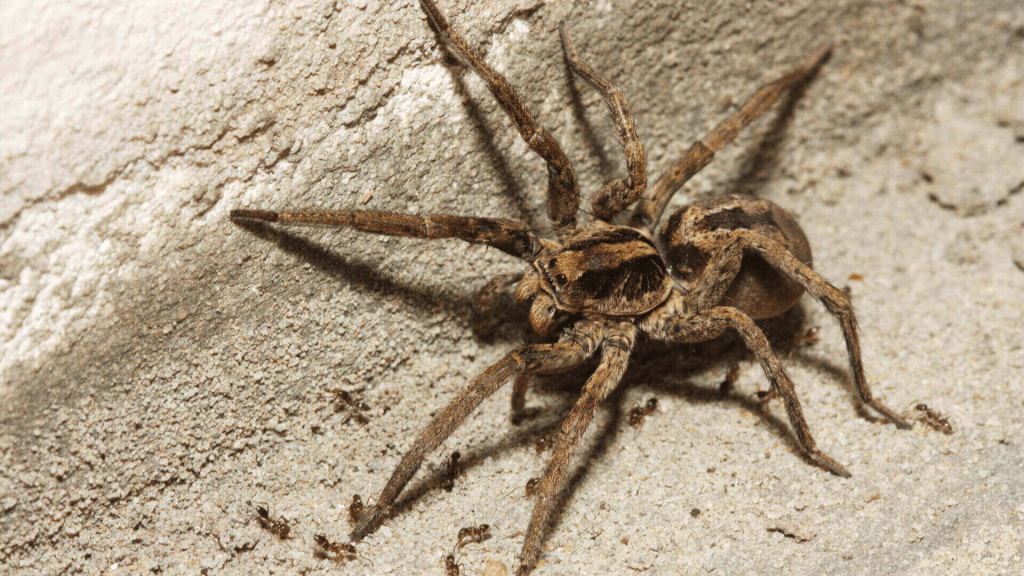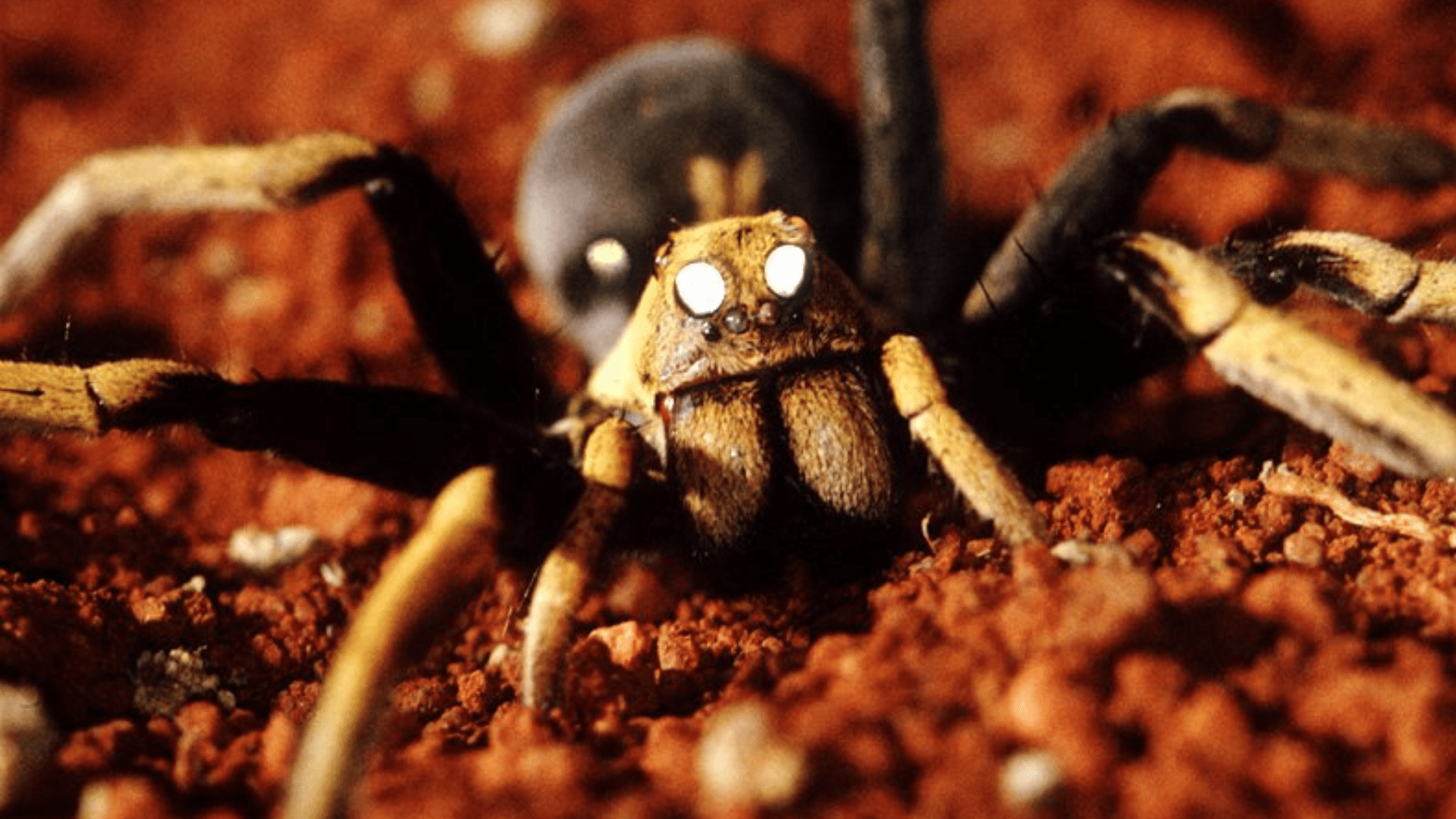Have you ever spotted a large, hairy spider darting across your floor and wondered what type it was?
It’s a wolf spider, a common eight-legged visitor in homes and gardens worldwide.
These spiders carry a name that sparks questions for many people.
The term “Wolf Spider” seems to hint at something fierce or predatory, but does it match the actual nature of these creatures?
This blog post will answer why these particular spiders earned their wolf-related name.
You’ll learn about their hunting methods, physical traits, behaviors, and also the truth behind the myths about them.
Let’s find out what makes a wolf spider truly wolf-like.
How Wolf Spiders Got Their Name?
Wolf spiders got their name from their hunting style.
Unlike many spiders that build webs to catch prey, these hunters chase and pounce on their targets, much like wolves hunt in the wild.
They rely on speed and strength rather than traps. Their eyes also play a part in the name.
Wolf spiders have eight eyes arranged in three rows, with two large eyes located at the top that shine in the dark when light hits them, similar to the eyes of wolves at night.
Plus, some species carry their young on their backs, which reminded early scientists of mother wolves carrying pups.
These hunting traits, eye structure, and parenting habits all led to the “wolf” in their name.
Physical and Behavioral Patterns of a Wolf Spider
Wolf spiders have distinct traits that set them apart from other spider types.
Their physical features and unique behaviors make them fascinating creatures to study in the natural world.
| Feature | Description |
|---|---|
| Physical Traits | |
| Size | Ranges from 0.5 to 2 inches long, with females typically larger than males. |
| Color | Usually brown, gray, or tan with striped or spotted patterns for camouflage. |
| Eyes | Eight eyes are arranged in three rows; two large forward-facing eyes on top. |
| Legs | Long, sturdy legs built for running and jumping. |
| Behavioral Patterns | |
| Hunting Style | Active hunters that chase and pounce on prey instead of using webs. |
| Night Activity | Mostly nocturnal, hunting more actively during nighttime. |
| Defense | Will raise front legs and show fangs when threatened. |
| Solitary Nature | Live and hunt alone except during mating season. |
| Burrowing | Many species dig or use existing burrows as homes. |
| Maternal Care | Females carry egg sacs and later carry babies on their backs. |
| Seasonal Changes | More visible indoors during fall when seeking warmer shelter. |
| Reaction to Light | Eyes reflect light at night, making them easy to spot with flashlights. |
Surprising Facts About Wolf Spider
Wolf spiders are full of surprises beyond their hunting habits and name origin. Here are some eye-opening facts about wolf spiders:
- Excellent Vision: Wolf spiders have among the best eyesight in the spider world, with two large eyes that can see objects up to 30 feet away.
- No Web Needed: These spiders don’t build webs to catch food, relying instead on their speed and strength to hunt prey directly.
- Can Swim: Many wolf spider species can walk on water and even dive beneath the surface when needed to escape threats.
- Quick Runners: Wolf spiders can run at speeds of up to two feet per second, making them one of the fastest spider species.
- Long Jumpers: They can jump up to eight times their leg span when hunting or escaping danger.
- Great Mothers: Female wolf spiders carry egg sacs with their spinnerets and then carry their babies on their backs for weeks.
- Loud Drummers: Male wolf spiders “drum” their legs on the ground to create vibrations that attract females during mating season.
- Night Glow: Their eyes shine bright green when light hits them at night, making them easy to spot with a flashlight.
- House Guests: Wolf spiders often enter homes in the fall and winter months looking for warmth, not to hunt humans.
- Temperature Adaptable: Wolf spiders can live in nearly all climates, from deserts to mountains and from the tropics to the Arctic.
- Sensitive Hair: The hair on their legs can detect air movements, helping them sense approaching prey or danger.
- Live Longer: Some wolf spider species can live up to four years, much longer than many other spider species.
- Stay Local: Most wolf spiders stay within a few feet of their birthplace, their entire lives if food is available.
- Winter Survivors: Unlike many spiders, wolf spiders don’t die in winter but remain active under snow or in protected areas.
- Beneficial Pest Control: A single wolf spider can eat thousands of insects in its lifetime, helping control pest populations naturally.
Busting Myths About Wolf Spiders
| Myth | Truth |
|---|---|
| Wolf Spiders Are Deadly to Humans | Wolf spider bites hurt, but aren’t deadly. Their venom causes only mild pain and swelling for most people. |
| They Chase and Attack People | Wolf spiders run toward humans only by accident. They actually try to escape when they notice people. |
| Wolf Spiders Infest Homes in Large Numbers | These spiders are loners. Finding many means you’ve seen the same spider multiple times or a different species. |
| They Jump at People’s Faces | Wolf spiders jump only to catch prey or escape. They have no interest in jumping at human faces. |
| All Big, Brown Spiders Are Wolf Spiders | Many common house spiders get mistaken for wolf spiders. True wolf spiders have a specific eye pattern. |
| Wolf Spiders Are Aggressive and Mean | These spiders are shy and prefer running away. They bite only when handled or trapped against the skin. |
| Wolf Spiders Will Crawl Into Your Bed | They prefer ground-level hiding spots, not beds or high furniture. They stay low where they can hunt better. |
Conclusion
Now you know why these speedy hunters got their wolf name.
Their hunting style, eyes, and family care all match wolf-like traits.
Wolf spiders play a crucial role in controlling pest populations in gardens and homes.
Though often feared, these eight-legged neighbors pose little threat to humans and prefer to avoid us when possible.





















